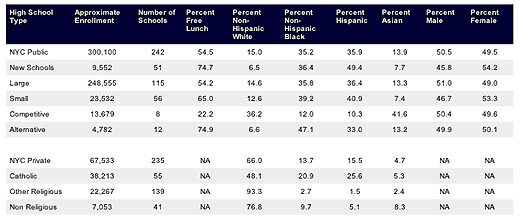New York City is restructuring its high schools. Some 42 new high schools were created last year, another 55 this year, and 45 more will be opened next year. Eventually, the plan is to replace all the large high schools with smaller schools, where the staff and the students will know one another better, and, so the thinking goes, the students will be encouraged to achieve more educationally.
What are the new schools like now, and how are they different from the other public schools? We can look at some answers using data from recently released “school report cards” for New York City combined with the most recent data on private high schools in New York City.
As the first table below shows, most New York City high school students are racial or ethnic minorities, but various high school categories draw very different mixes of students.

The average private school clearly serves a very different ethnic and racial clientele than the average public school. Overall, only 15 percent of New York City’s public high school students are white; by contrast, 66 percent of the private school students are.
It is important to keep in mind that 85 percent of all New York City students of high school age attend public high schools education as opposed to private ones.
So far, the transformation of New York City public schools does not seem to have affected the demographic composition of the various types of schools.
(To explain the definitions: The “new” high schools include those which were set up during the last several years, where often several schools share one building. The “large” high schools include the traditional local high school, as well as the vocational high schools. The “small” schools were established during earlier attempts to create small schools beginning in 1992. For this analysis, I am considering eight high schools as competitive; these include the traditionally competitive Stuyvesant, Bronx Science, Brooklyn Tech, and LaGuardia, the three new competitive high schools set up at Lehman, York and City College) and Townsend Harris in Queens, where it is difficult to gain admission. Alternative schools often serve students who are having problems in conventional educational settings.)
Among these different categories of public high schools, the ones that differ most markedly from the others are the competitive schools and the alternative schools. The competitive schools have a higher proportion of white and Asian students, a higher proportion of males, and a lower proportion of students on free or reduced lunch. The alternative schools on the other hand have a much lower proportion of white students and a higher proportion of students on free or reduced lunch (which is an indication of coming from a poverty-stricken household.)
The “new” high schools, on the other hand, seem to be drawing students roughly representative of all the public schools, as are the older “small” high schools, though the proportion of non-Hispanic whites is somewhat lower.

As for the ability of the students to meet the English and math standards – the new scores are not in yet. (The chart above shows the percentage meeting math and English standards of students newly admitted to the new schools. All that is clear is that some new schools seem to be aimed at low performing students.)
Whether the massive reorganization will improve educational outcomes for the vast bulk of New York City’s public high school remains to be seen.
Note on Sources
I am indebted to Lori Mei, Senior Instructional Manager, Assessment and Accountability, NYC Department of Education for supplying the data base used. The private school data were drawn from the Private School Universe Survey carried out by the National Center for Education Statistics of the US Department of Education. I also must acknowledge Jennifer Booher-Jennings of Columbia University for help with some of the school classification and in interpreting the results.
Andrew A. Beveridge has taught sociology at Queens College since 1981, done demographic analyses for the New York Times since 1993, and provides expert testimony on a range of cases, including housing discrimination. The opinions expressed are his alone.Â




